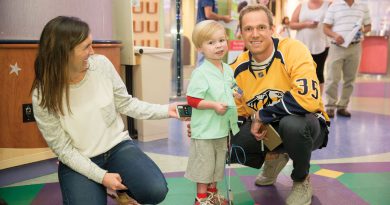There’s No Place Like Home
Published on June 28th, 2012 by Diana Duren.
by Leigh MacMillan

Lauren Helton knocks on the slightly open door of a 15-year-old patient’s room, pushes it open and flashes a big smile.
“Hi, I’m Lauren. I’m a volunteer, and I was wondering if you’d like to hang out, maybe play a game,” she says, her Louisiana accent rolling gently into the room.
The teen looks up from her cell phone, shrugs and mumbles, “Sure, I guess.”
“How about UNO? I’m pretty good,” Helton says.
“Sure, I guess,” the teen nods.
Before long, Helton is propped on the end of the bed, the cards are flying and the teen is laughing, questioning Helton’s skill, and confiding about the boyfriend whose text messages come buzzing in.
“I’ll check in on you later, girlfriend,” Helton says as she leaves the room.
On any given Tuesday evening, Helton might find herself in a room with a teenager, a young child, even a baby. She is a volunteer at the Monroe Carell Jr. Children’s Hospital at Vanderbilt – a position she took after joining the Junior League of Nashville.
Helton’s “job” is to play, to be a friendly new face, someone who cares and a distraction from the usual routine. She is one of the latest volunteers in a 90-year tradition of League members devoted to caring for the community’s children.
It was the League’s dedication 90 years ago to children’s health – and its Home for Crippled Children – that laid the foundation for a children’s hospital in Nashville. In a unique partnership with Vanderbilt University Medical Center, the League today supports a number of programs at Children’s Hospital that improve children’s health and wellness.
Founding the Home
The year was 1922. World War I had recently ended; Prohibition was in effect; and women had just won the right to vote.
Cornelia Keeble, a prominent young Nashville woman, had learned about Junior Leagues during her college years in Philadelphia. She decided that Nashville needed one of these organizations of young women devoted to improving the health and education of the less fortunate.
She recruited friends to her mission, and together they founded the Junior League of Nashville. Addressing the scourge of polio soon became their cause.
Poliomyelitis (polio) is an acute, viral infectious disease. By 1922, polio epidemics – especially during the summer months – had become regular events that left thousands of children and adults paralyzed.
The League members learned from a local orthopaedic surgeon that Nashville lacked a place where children with polio, or other orthopaedic problems, could convalesce. Without long-term rehabilitation, these children would likely never lead normal lives.
The young women made an audacious decision: they would establish a convalescent home for children recovering from polio and other crippling diseases. And their home would not be a cold, sterile institution – like so many that existed at the time. Instead, it would be warm and inviting, like a family’s home.
In 1923, they convinced the Standard Oil Company to let them use a house at Ninth Avenue and Monroe Street – “rent-free of course,” says Fran Hardcastle, the League’s president from 1975-1976. “Doctors donated their services, the Junior League women provided everything else, and the Junior League Home for Crippled Children was born.”
With only one nurse on staff, members took care of all of the day-to-day routine care of the children and of the Home.
“They brushed their hair, cooked their meals, did laundry, cleaned, changed sheets, all of that,” says Mary Lee Bartlett, the League’s president from 2005-2006.
Plenty of TLC
“The Home,” as it came to be affectionately known, was soon bursting at the seams and the women of the League set their sights on expanding.
With community and state support and Junior League funds, the League opened a custom-built convalescence facility in 1930. The new Home boasted a physiotherapy room with cheerful paintings of large circus animals on the walls and toys including tricycles, balls and various games. There was a library full of books, an open-air pavilion, and outdoor recreation areas, even a swimming pool.
By the 1960s, when Hardcastle became a member of the Junior League, the Home was operating as an accredited hospital, free of charge to patients, with community and Vanderbilt physicians donating their services. Hardcastle, like all new members of the League, volunteered at the Home during her first year.
“You might read to a child, help them eat at lunchtime, wheel them outside to the play area – nothing that took any special skills – but it was very rewarding to feel what a difference you could make with your presence and your support,” she says.
“The emphasis was always on creating as much of a home-like atmosphere as possible for these sick children. There was plenty of TLC.”
Bringing smiles
Between 30 and 40 Junior League members volunteer at Children’s Hospital each year, continuing the tradition of
providing lots of TLC.
Lauren Helton is one of them. And so on Tuesday evenings, she dons her blue volunteer vest, her ID badge, and her smile, and she plays.
Helton had lived in Nashville only a few years and was interested in becoming more involved in the community.
“I wanted to be part of an organization that volunteered, and the Junior League seemed to be a good fit for me,” she says.
The Junior League of Nashville is open to all women age 23 or older, who are committed to its mission of voluntarism. In their first year, new members learn about the League, its partner agencies and wide array of volunteer opportunities. Helton, who sells medical equipment for premature infants, was drawn to Children’s Hospital.
“I see a lot of premature babies in my work, and I feel powerless – there’s nothing I can do to raise their spirits,” she says. “The Children’s Hospital seemed like a place where I could make a difference in a child’s life, and that’s really important to me.”

Helton says the experience has taught her to be more flexible, enjoy everything she can, and not sweat the small stuff.
“These children are so amazing. Even though they’re going through so much, they like to see a new face; they like to have fun,” she says. “It makes me happy to be able to put a smile on their faces.”
Many of the Junior League volunteers, such as Helton, make a weekly commitment of two or more hours, said Stephanie Van Dyke, director of Volunteer Services.
“Junior League volunteers host special events and spend time with patients and families in our playrooms and at the bedside – they’re providing that companionship and friendship that we know reduce stress and anxiety,” Van Dyke says. “The Junior League volunteers are also busy working behind the scenes to ensure that we have donations of items for the comfort cart (travel-sized personal items and snacks for patients’ families) and age-appropriate gifts available in clinics such as the Neonatal Follow-Up Clinic. They offer support for patients and families in a multitude of ways.”
Supporting the Home
The founding Junior League members recognized the need for an ongoing source of financial support for their endeavors – past and present.
That support began in the form of the annual “Paper Sale.”
The Newspaper Printing Corporation, which printed the competing daily papers, the Nashville Banner and The Tennessean, agreed to print a special edition that featured stories about the Home. The League received proceeds from the street “sales” of the special edition – “there was no price, you just asked for a donation,” Hardcastle says – and from advance solicitations from community businesses.
With help from the Shriners of the Al Menah Temple, the “Palm Sunday Paper Sale” was conducted in all 41 counties served by the Home.
“The value of the Paper Sale was far greater than the monies raised from ‘selling’ a publication,” Hardcastle says. “The stories of the children served became known throughout Middle Tennessee.”
Hardcastle remembers going door-to-door in neighborhoods – poor and wealthy – and trying to “hit every door before people had gone to church.” People wanted to give, she says, because “everybody had a connection with somebody who’d been in the Home.”
From Paper Sale income and various bequests, the Junior League established a trust fund for the operation and maintenance of the Home. After the Junior League and Vanderbilt agreed to partner and the Home moved to Vanderbilt, income from the trust supported facilities, care for children, and the founding of programs that have become enduring parts of the children’s health care landscape.
A special partnership
Before the late 1960s, the Junior League and Vanderbilt had limited interaction – the League ran its Home and Vanderbilt physicians saw patients there or in their own clinics. But times were changing. Children served by the Home had more acute medical needs, and federal or insurance payments were becoming available, but the Junior League had never accepted payments and was not equipped to do so.
The League decided that a children’s hospital, which was taking shape at Vanderbilt, could address both issues.
David Karzon, M.D., who arrived at Vanderbilt as the chair of Pediatrics in 1968, proposed a “hospital within a hospital” concept – a children’s hospital that would reside within the University Hospital. Karzon believed a children’s hospital was not just bricks and mortar, but also a philosophy about the delivery of health care for children.
The Vanderbilt Board of Trust approved the formation of the Children’s Regional Medical Center (CRMC) in 1970, appointed Karzon its first medical director, and offered the new center shell space.
With the concept in place for a hospital dedicated to children, the Junior League of Nashville partnered with Vanderbilt to move the Junior League Home to the CRMC.
As part of the move, the League outfitted an educational room and a playroom – colorful places of refuge filled with books, toys, games and art supplies – rooms that were like the spaces they had always had in the Home.
“Nobody had ever heard of having a playroom for sick children in the hospital, but the Junior League provided that and other non-medical types of things that were necessary for helping a child heal,” Hardcastle says.
The Junior League playroom heralded the beginning of what is now a thriving Child Life Services Program, which supports multiple play and activity rooms with services tailored to the unique developmental needs of each child.
Mary Lee Bartlett, the League president from 2005-2006, spent about five years making weekly visits to patients at Children’s Hospital during the years that it resided within Vanderbilt University Hospital.
She remembers one child – “the funniest kid ever” – in particular.
“His favorite thing to do was play a certain video game and beat me,” she laughs. “He beat me over and over and over again. I think he looked forward to Thursdays because he knew he would get to beat me at that game.
“You get to be with a lot of great kids and make their days a little brighter, and that’s what kept me coming back.”
Lasting legacy
The Junior League Home moved twice more with Children’s Hospital: to its own floors in the new Vanderbilt University Hospital and then to the freestanding Children’s Hospital in 2004. The Junior League donated $2 million to build the new hospital.
“We are proud of the Junior League and Vanderbilt’s shared history of providing the very best health care to the region’s children, and we look forward to continuing our productive partnership,” says Jeff Balser, M.D., Ph.D., vice chancellor for Health Affairs and dean of the School of Medicine. “The Junior League of Nashville has had 90 remarkable years of building community leaders and serving the people of Middle Tennessee.”
The League’s participation in the planning process for the new hospital – and the continuing role of its members on decision-making committees – also helped form the model of patient and family-centered care that permeates Children’s Hospital today.
“We knew from experience how important it was to care for a child in an environment that was designed for them,” Hardcastle says.
“There’s a great sense of pride (among members) for the role that the League played in the fact that there is a children’s hospital in Nashville,” Bartlett says, “and that it’s not a hospital treating children like they’re miniature adults, but a hospital treating children appropriate to the age that they are.
“To see how far the hospital has come and the programs the League has made possible with our partnership…it’s gratifying.”
And through that partnership, children continue to see smiling faces, play a friendly game and know someone cares. These are things that have always been part of the Junior League Home.
“It’s a place of security, a place of rest, a place to find healing, a place where you’re going to get what you need,” Bartlett says. “That’s what home is about.”
To learn more about the Junior League of Nashville, visit jlnashville.org



